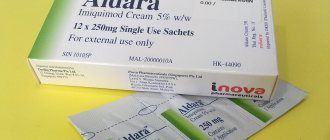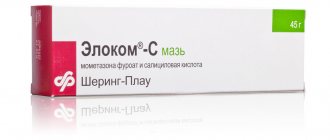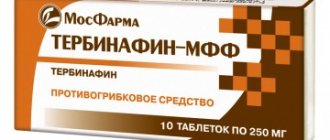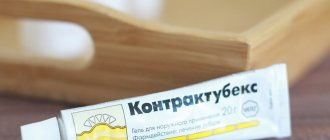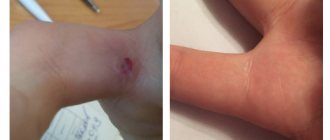Pharmacodynamics and pharmacokinetics
When used externally, this drug, due to its active component mometasone , exhibits an anti-inflammatory, antipruritic and anti-exudative effect.
It has been established that absorption of both ointment and cream is very insignificant. After 8 hours from the moment of applying the external agent to an intact skin surface without using an occlusive dressing, about 0.4-0.7% of the active substance enters the systemic bloodstream. Mometasone is metabolized in the liver. The drug is excreted from the body, mainly through the kidneys and a small amount with bile .
Contraindications for use
This external remedy is not prescribed for:
- rosacea;
- perioral dermatitis;
- bacterial, viral or fungal infection of the skin;
- tuberculosis, syphilis;
- post-vaccination reactions;
- under 2 years of age - ointment;
- lactation, pregnancy when used for a long time, over large areas and in large quantities;
- high sensitivity to GCS and other components of the drug.
You should also be careful when applying the drug to intertriginous skin and face, using with occlusive dressings, in large quantities or large areas of skin.
Instructions
The list of adverse events below is based on data from clinical studies in seasonal and perennial allergic rhinitis, as well as data from post-registration use of individual components of the drug.
Seasonal allergic rhinitis
In a clinical study conducted in 560 patients aged 12 to 65 years with seasonal allergic rhinitis, 282 patients received azelastine hydrochloride + mometasone furoate nasal spray for an average of 14.94 days.
Overall, the safety profile of azelastine hydrochloride + mometasone furoate nasal spray was comparable to the profiles of the individual components used as monotherapy in the study, and was also consistent with the available published data on monotherapy with the individual components of the combination. A total of 18 adverse events associated with the use of azelastine hydrochloride + mometasone furoate nasal spray were reported in 11 of 282 patients. The most common adverse events recorded in the study were headache (5 cases) and dysgeusia (5 cases). Other adverse events were drowsiness (3 cases), lethargy (2 cases), nausea (1 case), dyspepsia (1 case) and sneezing (1 case). Most of these adverse events were mild in severity, and no serious adverse events were reported during the study.
In another clinical study conducted on 220 patients with seasonal allergic rhinitis, 55 patients received azelastine hydrochloride + mometasone furoate nasal metered spray, 1 spray in each nostril twice a day in the morning and evening, 55 patients received azelastine hydrochloride + nasal metered spray. mometasone furoate 2 injections into each nostril once a day, 55 patients dosed spray mometasone furoate and 55 patients dosed spray azelastine hydrochloride. The duration of treatment with these drugs was 14 days. During the entire study period, adverse events were identified in 51 participants (23%). During the study, the following adverse events were noted: drowsiness (0.9%), bitter taste in the mouth (3.6%), headache (2.7%), nosebleeds (1.8%), burning sensation in the nose after application (9.5%), sneezing after use (4.1%), increased appetite (0.5%), dry nose (4.1%), abnormalities in tests (0.9%), swelling of the mucous membrane nose (0.5%), nasal congestion (0.5%), rhinorrhea (0.9%), sinus arrhythmia (0.9%), redness of the hands (red spots) (0.5%), dry eyes ( 0.5%), hemorrhagic exanthema (0.5%), abnormal urinalysis (0.5%), swelling of the eyelids (0.5%), burning sensation in the eye area (0.5%) and loss of smell ( 0.5%). Mild adverse events accounted for 74.5%, and moderate adverse events accounted for 25.5% of the total number of adverse events.
Year-round allergic rhinitis
In a clinical study conducted in 150 patients with perennial allergic rhinitis, 75 patients received azelastine hydrochloride nasal metered spray + mometasone furoate, and 75 patients received combination therapy with azelastine hydrochloride nasal metered spray and mometasone furoate nasal metered spray from different devices. The duration of treatment with these drugs was 28 days. During the entire study period, 51 adverse events were reported in 23 of 150 patients (15.33%). The most common adverse events reported in the study were headache (10 cases), nosebleeds (6 cases), excessive sneezing (5 cases), and mucosal burning sensation (4 cases). Most adverse events were mild or moderate in severity, and no serious adverse events were reported during the study. A comparative analysis of the observed adverse events in the groups revealed no differences between the groups. During the study, 94.74% (18/19) of mild adverse events and 5.26% (1/19) of moderate adverse events were observed in the group of patients receiving azelastine hydrochloride + mometasone furoate nasal dosed spray.
The following are adverse drug events reported with the use of individual components of the fixed-dose combination.
According to the World Health Organization (WHO), adverse events are classified based on systemic organ classes according to the frequency of their development as follows:
very often - ≥ 1/10; often - from ≥ 1/100 to infrequently - from ≥ 1/1000 to rarely - from ≥ 1/10000 to very rarely - frequency unknown - it is not possible to determine the frequency of occurrence based on available data.
Azelastine hydrochloride
Often:
after use, a substance-specific bitter taste may be felt (often due to improper use, namely by excessively tilting the head back during use), which in rare cases can cause nausea.
Infrequently:
Mild, transient irritation of the inflamed nasal mucosa may occur, with symptoms such as burning, itching, sneezing and nosebleeds.
Very rarely:
Hypersensitivity reactions (such as rash, itching, urticaria), anaphylactoid reactions, dizziness, fatigue, drowsiness, weakness (may be due to the disease itself) have been reported.
Mometasone furoate
Adverse events associated with the use of the drug (≥1%) identified during clinical trials in patients with allergic rhinitis or nasal polyposis, and during post-registration use of the drug, regardless of the indication for use, are presented below. The overall incidence of adverse events in patients treated for acute rhinosinusitis was comparable to the incidence in patients with allergic rhinitis and placebo.
Nosebleeds, as a rule, were moderate and stopped on their own, the frequency of their occurrence was slightly higher than when using placebo (5%), but equal or less than when prescribing other intranasal corticosteroids, which were used as an active control (in some of In them, the incidence of nosebleeds was up to 15%). The incidence of all other adverse events was comparable to that observed with placebo.
Infectious and parasitic diseases:
often - pharyngitis, upper respiratory tract infections*
Immune system disorders:
frequency not established - hypersensitivity reactions, including anaphylactic reactions, angioedema, bronchospasm, shortness of breath.
Nervous system disorders:
often - headache.
Visual disorders:
frequency not established - increased intraocular pressure, glaucoma, cataracts, blurred vision (blurred vision).
Disorders of the respiratory system, chest and mediastinal organs:
very often - nosebleeds**; often - nosebleeds (i.e. obvious bleeding, as well as the release of blood-stained mucus or blood clots), burning sensation in the nose, irritation of the nasal mucosa, ulceration of the nasal mucosa; frequency not established - perforation of the nasal septum.
Gastrointestinal disorders:
often - pharyngeal irritation (feeling of irritation of the pharyngeal mucosa)**; frequency not established - disturbance of taste and smell.
* — detected with a frequency of “rarely” when using the drug 2 times a day for nasal polyposis;
** — detected when using the drug 2 times a day for nasal polyposis.
When using intranasal corticosteroids, systemic side effects may develop, especially with long-term use of intranasal corticosteroids in high doses.
If you experience the side effects listed in the instructions or they get worse, or you notice any other side effects not listed in the instructions, tell your doctor.
special instructions
When Momat ointment or is applied to large areas of the skin surface for a long time or under a bandage, there is a possibility of developing symptoms of suppression of the functions of the hypothalamic-pituitary-adrenal system or Cushing's syndrome.
Sometimes, due to propylene glycol, which is part of Momat, irritation occurs at the application site. Such cases require discontinuation of the drug and the appointment of appropriate therapy.
It must be remembered that some GCS change the manifestation of a number of skin diseases, which makes diagnosis difficult. Also, such drugs often delay wound healing.
Long-term treatment with Momat and sudden withdrawal can cause the development of rebound syndrome, which is manifested by dermatitis with severe burning and redness of the skin. For this reason, after long-term therapy, drug withdrawal is carried out gradually, for example, in the form of a transition to an intermittent treatment regimen until it is completely stopped.
When using Momat cream or ointment, it is necessary to protect the mucous membrane of the eye from contact with it.
Momat
Momat (mometasone) is an artificially synthesized local glucocorticosteroid. Available in the form of cream and ointment. Relieves inflammation, eliminates itching, prevents exudation. Stimulates the formation of proteins that suppress the activity of acetylhydrolase, platelet activating factor and lipomodulins, which, in turn, are responsible for the synthesis of biologically active substances that provide chemical and molecular bonds in the site of inflammation and ensure the development of the inflammatory reaction - prostaglandins and leukotrienes. This occurs due to inhibition of the release of the latter's precursor, arachidonic acid. When applied externally, mometasone is only slightly absorbed into the systemic bloodstream (8 hours after its application to the skin, no more than 0.5% of the active substance penetrates into the blood). The drug undergoes intensive metabolic transformations by microsomal liver enzymes. Elimination from the body is carried out mainly by the kidneys and, to a lesser extent, by the intestines. Momat is indicated to eliminate itching and inflammation in dermatoses (dermatitis, eczema, etc.) that respond to the action of glucocorticosteroids. Momat is contraindicated in case of individual intolerance to mometasone, rosacea, dermatitis of the perioral area, bacterial, viral (herpes, chickenpox, shingles) or fungal skin lesions, reactions that occur after preventive or therapeutic vaccination, as well as during pregnancy and breastfeeding (in the latter In this case, this means long-term treatment or use of the drug in submaximal and maximum doses).
It is recommended to take special care when using Momat on the face or under an airtight bandage. Frequency of use – 1 time per day. The duration of pharmacotherapy is determined by the doctor depending on the effectiveness of the treatment, the patient’s tolerability of the drug, and the presence and severity of unwanted side reactions. With prolonged use of Momat, as well as other local glucocorticosteroids, the risk of developing systemic side effects increases (this is especially true for patients of younger age groups, as well as cases of using the drug under an airtight bandage). Given this fact, patients should be monitored to prevent the development of hypocortisolism syndrome and suppression of the hypothalamic-pituitary-adrenal system. As one of the auxiliary components, Momat contains propylene glycol, which can cause local allergic reactions. If the latter develop, the medication course should be suspended. It must be borne in mind that Momat, as well as other external glucocorticosteroids, can modify the clinical signs of some dermatological diseases, which makes their diagnosis difficult.
Use in pediatrics
Momat ointment is contraindicated for use in children under 2 years of age. It is known that in young patients the ratio of skin surface area to weight is greater than in adults, therefore children are at greater risk of suppressing the functions of the hypothalamic-pituitary-adrenal axis and developing Cushing's syndrome during external use of this drug.
Long-term therapy with Momat often leads to disruption of the development and growth of the child. Therefore, children are prescribed the drug in the minimum dosage sufficient to obtain a positive effect.
Momat ointment for external use 0.1% 15g
Directions for use and doses
Externally.
A thin layer of Momat ointment is applied to the affected areas of the skin once a day.
The duration of treatment is determined by its effectiveness, as well as patient tolerability, the presence and severity of side effects.
Storage conditions
At a temperature not higher than 25°C.
Do not freeze. Keep out of the reach of children.
Best before date
2 years. Do not use the drug after the expiration date.
special instructions
When used on large areas of skin for a long time, especially when using occlusive dressings, systemic action of GCS may develop. Given this, patients should be monitored for signs of suppression of the hypothalamic-pituitary-adrenal axis and the development of Cushing's syndrome.
It should be borne in mind that GCS can change the manifestations of some skin diseases, which can complicate the diagnosis. In addition, the use of GCS may cause a delay in wound healing.
With long-term therapy with GCS, sudden cessation of therapy can lead to the development of rebound syndrome, manifested in the form of dermatitis with intense redness of the skin and a burning sensation. Therefore, after a long course of treatment, the drug should be discontinued gradually, for example, by switching to an intermittent treatment regimen before stopping it completely.
Any of the side effects described with systemic use of GCS, including suppression of adrenal function, can also occur with external use, especially in children.
Use in pediatrics
Due to the fact that in children the ratio of surface area to body weight is greater than in adults, children are at greater risk of suppressing the function of the hypothalamic-pituitary-adrenal axis and developing Cushing's syndrome when using any topical corticosteroids. Long-term use of GCS in children can lead to disturbances in their growth and development.
In children it should be used in the minimum effective dose.
Description
Glucocorticosteroid for external use.
Dosage form
Ointment for external use is white.
Use in children
Contraindication: children under 2 years of age.
Pharmacodynamics
GCS for external use. It has anti-inflammatory, antipruritic and antiexudative effects. GCS induce the release of phospholipase A2 inhibitory proteins, collectively known as lipocortins, which control the biosynthesis of inflammatory mediators such as prostaglandins and leukotrienes by inhibiting the release of their common precursor, arachidonic acid.
Side effects
Infections and infestations: rarely - folliculitis, secondary infection.
From the skin and subcutaneous tissues: rarely - irritation and dryness of the skin, burning sensation, itching, hypertrichosis, acne, hypopigmentation, perioral dermatitis, allergic contact dermatitis, secondary infection, skin maceration, signs of skin atrophy, stretch marks, prickly heat, formation papules, pustules.
From the nervous system: frequency has not been established - paresthesia.
When using external forms of GCS for a long time and/or to treat large areas of skin, or using occlusive dressings, especially in children and adolescents, side effects characteristic of systemic GCS may occur, including adrenal insufficiency and Cushing's syndrome.
Use during pregnancy and breastfeeding
Contraindicated for use during pregnancy on large areas of skin for a long time; during breastfeeding.
Interaction
No interaction of the drug Momat, ointment for external use with other drugs has been registered.
Overdose
Symptoms: inhibition of the function of the hypothalamic-pituitary-adrenal system, including secondary adrenal insufficiency.
Treatment: symptomatic, if necessary - correction of electrolyte imbalance, drug withdrawal (with long-term therapy - gradual withdrawal).
Impact on the ability to drive vehicles and operate machinery
The effect of the drug Momat, an ointment for external use, on the ability to drive a car or move machinery has not been noted.
Side effects
When treated with Momat cream or ointment, undesirable symptoms may occur that affect the activity of the endocrine system, for example, adrenal insufficiency or Cushing's syndrome . It is also possible to develop dermatological or allergic reactions in the form of: skin irritation, dry skin, burning, folliculitis, hypertrichosis, acne, perioral dermatitis, and so on.
Momat's analogs
Level 4 ATC code matches:
Gistan-N
Sinalar
Avecourt
Mesoderm
Momederm
Betazon
Silkaren
Elokom
Flucinar
Sinaflan
Celestoderm
Cutivate
Advantan
Betamethasone
Beloderm
Mometasone Furoate
Uniderm
The main analogues of this external remedy are: Asmanex, Mometasone, Elokom and Uniderm.
Reviews about Momat
As a rule, reviews of Momat cream are found on forums where various childhood diseases are discussed. At the same time, many mothers say that they use this remedy in the treatment of childhood diathesis, atopic dermatitis . It is also reported that this cream is often prescribed for very young patients. Although some parents doubt the correctness of the therapy, the effectiveness of this remedy appears in a fairly short time.
In addition, on the Internet you can find many comparisons of this drug with other drugs. However, reviews of Momat ointment show that most patients have made their choice and, if necessary, use this particular product.
Some users are interested in whether this ointment is hormonal or not, since patients often refuse treatment with any hormonal drugs, considering them especially harmful to health.
It should be noted that psoriasis or atopic dermatitis are systemic diseases. Therefore, competent therapy should be aimed not only at suppressing symptoms, but also the condition of the entire organism.
It is not always possible to completely restore the health of such patients, but the general condition can be successfully controlled. Therefore, in addition to using hormonal ointments, like Momat, it is necessary to carry out other procedures that can affect the course of the disease - monitor the diet , avoid allergens , normalize metabolism , etc.
Momata price, where to buy
In Russian pharmacies, the price of Momat ointment for external use 0.1% is 216-269 rubles. The price of Momat cream for external use 0.1% varies between 171-269 rubles.
- Online pharmacies in RussiaRussia
- Online pharmacies in KazakhstanKazakhstan
ZdravCity
- Momat Rino Advance nasal spray.
dosage 140mcg+50mcg/dose 150 dosesGlenmark Pharmaceuticals LTD RUB 671 order - Momat Rino nasal spray. dosage 50 mcg/dose vial. 120 doses (with dispensing device) Glenmark Pharmaceuticals LTD
468 RUR order
- Momat Rhino Advance sp. called dosage 140 mcg+50 mcg/dose vial. 75 doses Glenmark Pharmaceuticals LTD
RUR 456 order
- Momat rhino spray nasal doser. 50mcg/dose vial. 60dosesGlenmark Pharmaceuticals LTD
RUR 326 order
Pharmacy Dialogue
- Momat ointment (tube 0.1% 15g)Glenmark Pharm
75 rub. order
- Momat Rhino Advance (spray 140mcg+50mcg/dose bottle 75doses)Glenmark Pharm
450 rub. order
- Momat Rhino spray 50mcg/dose 120doses (with dosing device)Glenmark Pharm
RUB 473 order
- Momat Rhino Advance (spray 140mcg+50mcg/dose 150doses (oral dose)) Glenmark Pharm
RUR 693 order
- Momat cream 0.1% 15Glenmark Pharm
76 RUR order
show more
Buy Momat ointment 0.1% 15g in pharmacies
Instructions for use Momat ointment 0.1% 15g
Dosage forms ointment 0.1% 15g Synonyms Avecort Asmanex Twistheiler Gistan-N Desrinit Nasonex Uniderm Elokom Elokom Lotion Group Products with glucocorticosteroid activity International nonproprietary name Mometasone Composition Active substance: Mometasone. Manufacturers Glenmark Pharmaceuticals Ltd (India) Pharmacological action Anti-inflammatory, antiallergic, antiexudative, antipruritic. Induces lipocortins, proteins that inhibit phospholipase A2. As a result, the liberation of arachidonic acid from membrane phospholipids is inhibited and the biosynthesis of prostaglandins and leukotrienes is disrupted. With daily application of the cream to children over 2 years of age with allergic dermatitis, the therapeutic effect appears within 3 weeks. Side effects Ointment, cream, lotion: burning, itching, tingling and tingling sensation, paresthesia, folliculitis, acne, skin atrophy, hypertrichosis, hypopigmentation, perioral dermatitis, allergic contact dermatitis, skin maceration, secondary infection, stretch marks, prickly heat. Intranasal aerosol: burning sensation in the nose, irritation of the nasal mucosa, nosebleeds, pharyngitis. Indications for use Psoriasis, atopic dermatitis and other dermatoses, incl. in the scalp area; allergic rhinitis, seasonal and chronic (treatment and prevention). Contraindications Hypersensitivity, pregnancy and breastfeeding, children (up to 2 years). Overdose Symptoms of hypercortisolism may develop. Treatment: discontinuation of the drug, if necessary, correction of electrolyte imbalance. With intranasal use: bloody discharge (mucus or blood clots) appears from the nasal passages; the applications are stopped; no special treatment is required. Interaction No information available. Special instructions Not intended for use in ophthalmology. Adrenal function should be regularly monitored (so as not to miss the symptoms of hypercortisolism). Nasal inhalations are not recommended after recent surgery or trauma to the nose. Prescribed with caution for active or latent forms of tuberculosis, untreated fungal, bacterial or viral infections, Herpes simplex with eye damage. If local infections of the nose or throat develop, mometasone is gradually discontinued. Treatment of children is carried out according to strict indications and under medical supervision, because systemic side effects may develop. Storage conditions List B. In a place protected from light, at room temperature.
